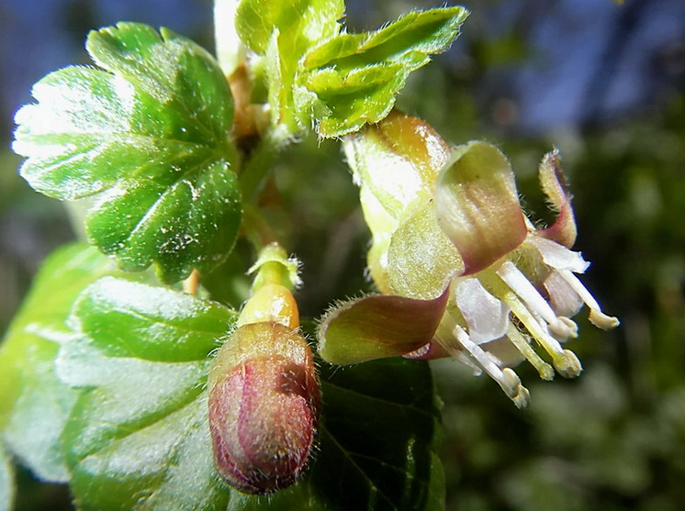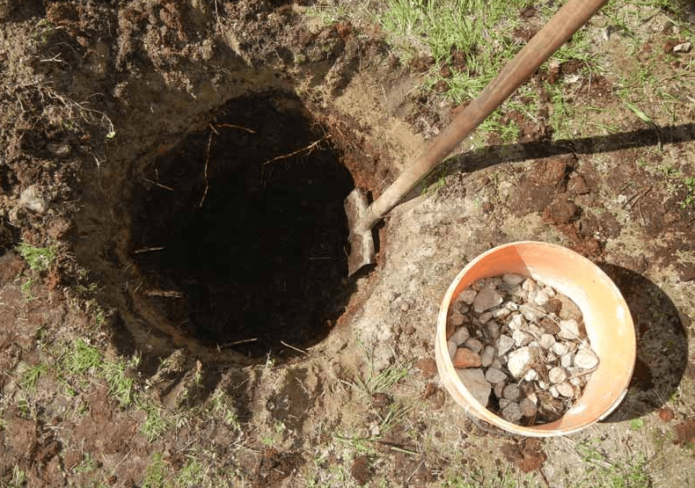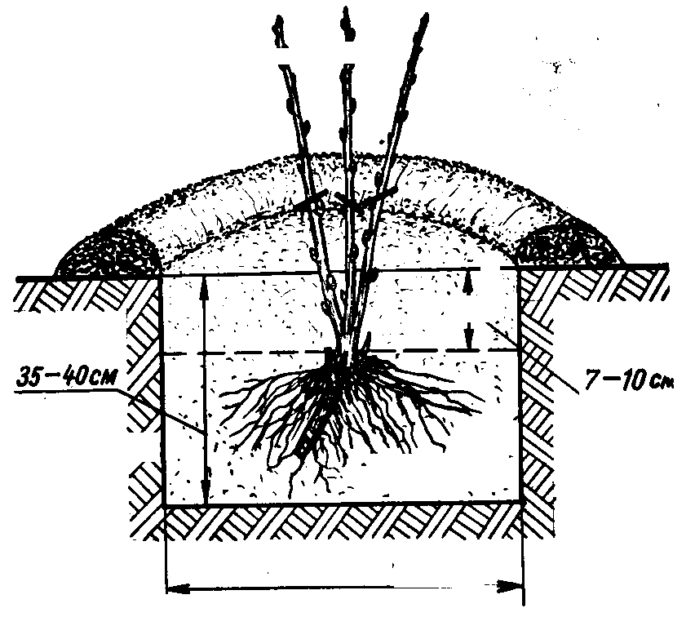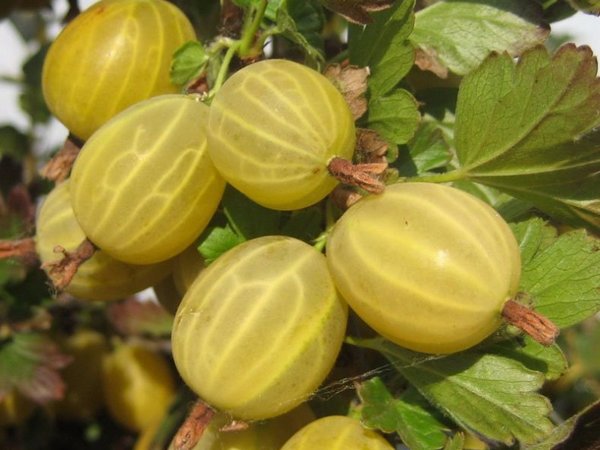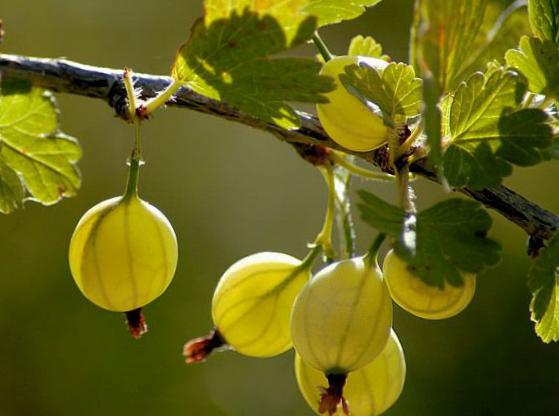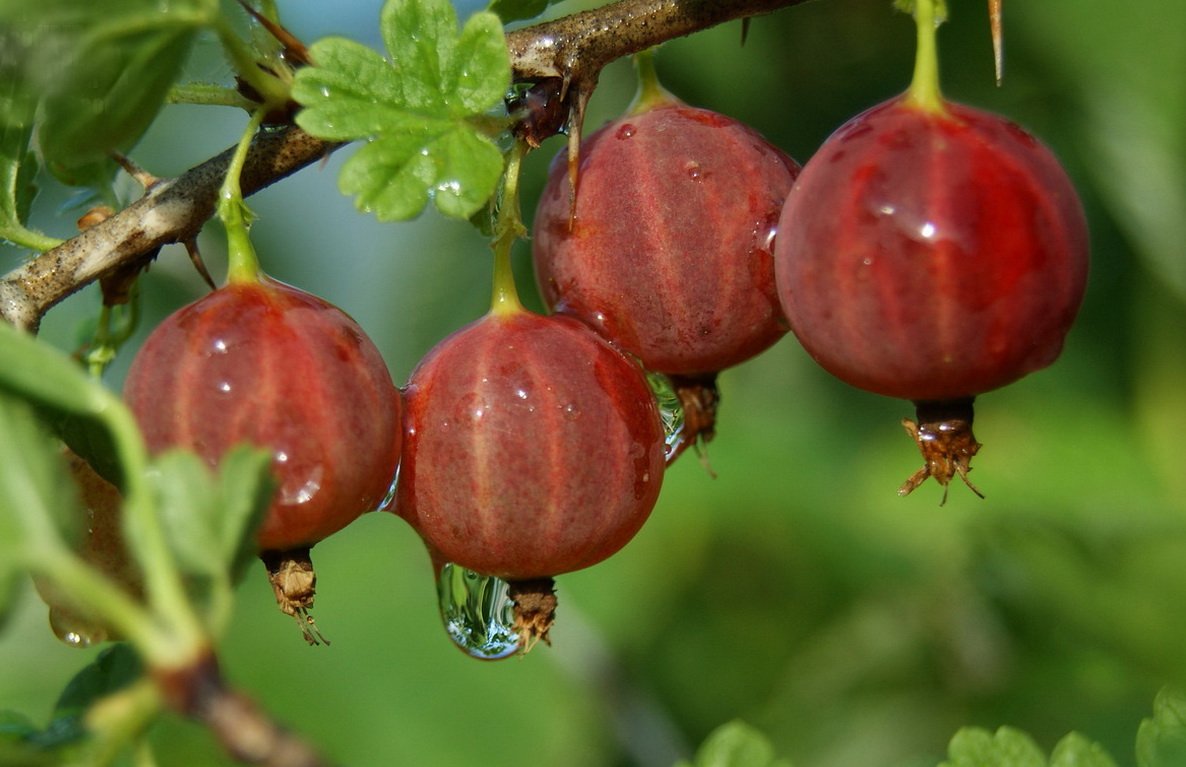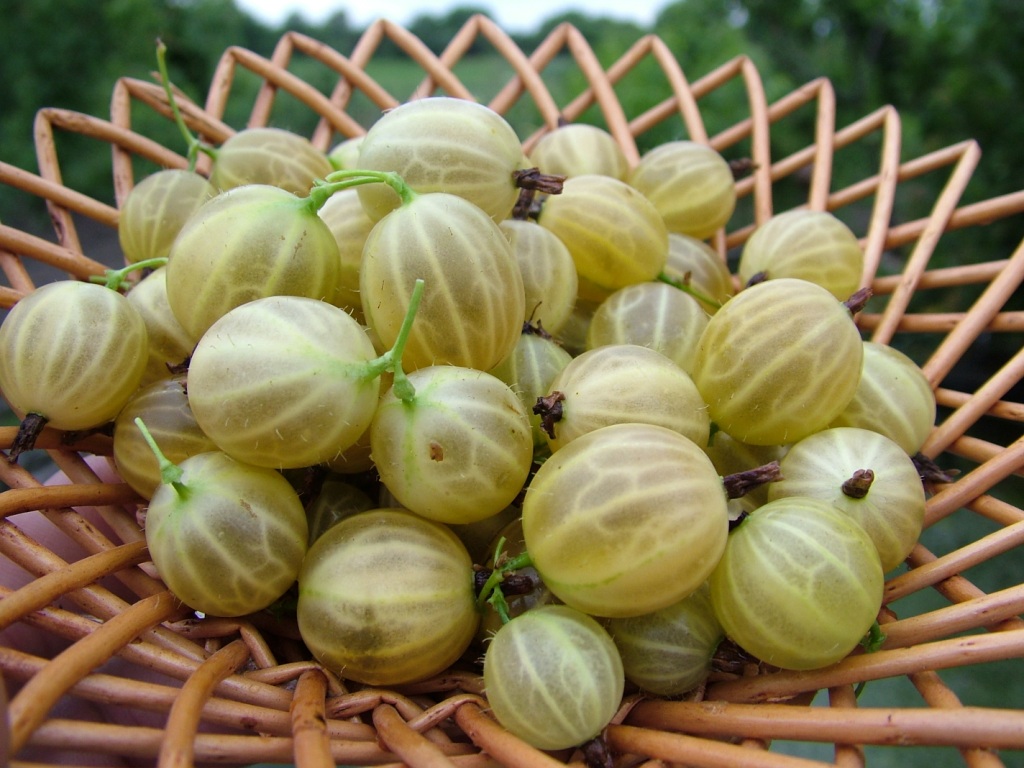Handsome gooseberry with emerald leaves and amber berries is a decoration of a summer cottage. It is difficult to imagine that such beauty is possible near St. Petersburg or near Chelyabinsk. But Russian yellow gooseberry has been growing here and has been giving tender berries for half a century.
Content
History of breeding, description and characteristics of the gooseberry variety Russian yellow
The author of the variety, Klavdia Dmitrievna Sergeeva, received this gooseberry through careful selection in 1963. The Russian yellow variety has been included in the State Register since 1974 in the Northwestern and Ural regions.
It is not very tall, slightly spreading bush. Young shoots are gray-green, straight. Lignified branches are light. The variety is prickly, single thorns, concentrated mainly on the lower parts of the shoots. The leaves are five-lobed, without pubescence, bright green, glossy. The flowers are pale, medium-sized, single or in pairs in inflorescences.
Large, rounded-oval berries are devoid of pubescence, honey-yellow, glossy. Their weight is usually within 5-7 g. The skin of the fruit is thin, with light veins, the pulp is sweet and sour, with a delicate taste, there are few seeds in it. Their purpose is universal: they are eaten fresh, frozen and preserved. The fruits tolerate transportation well. The berries hang on the bush for a long time, do not crumble or crack.
Gooseberries contain many organic acids and vitamins. They are also rich in pectin, which binds heavy metals to form insoluble compounds, which are then excreted from the body. Therefore, it is especially useful to consume gooseberry fruits for residents of large cities and drivers who are forced to inhale toxic exhaust gases.
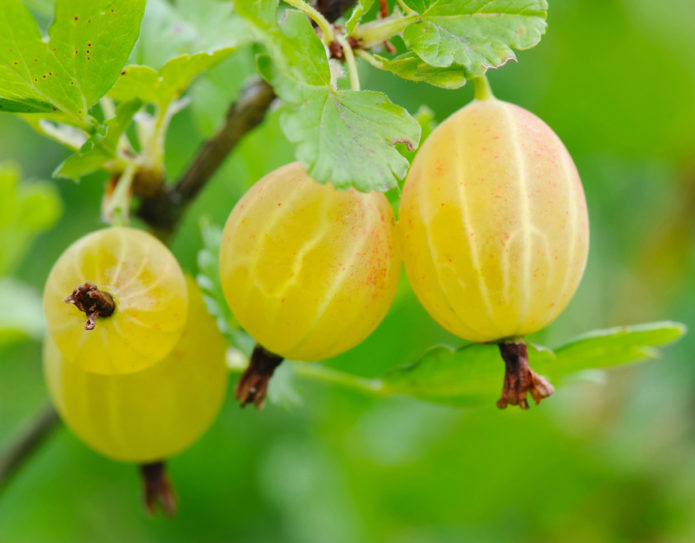
Gooseberry berries Russian yellow hang on the branches for a long time, without cracking or crumbling
This is a mid-season variety that shows high winter hardiness and drought resistance. The advantage of the Russian yellow gooseberry variety is also in its low sensitivity to spheroteca.
Spheroteka is an American powdery mildew, the scourge of many ancient gooseberry varieties. It is noticed that the more refined and richer the taste of the berry, the less resistant the plant to disease.
The Russian yellow gooseberry has a pronounced self-fertility, providing a bountiful harvest. 4.1 kg of berries or 120-140 kg / ha are harvested from the bush.
Experienced gardeners know that even with a pronounced self-fertility of the bushes, the yield is higher and better if other varieties of gooseberries that are close in ripening are planted in the neighborhood.
There are practically no disadvantages of this gooseberry. It is necessary to observe agricultural techniques and collect a well-deserved harvest.
Features of planting and cultivation of the gooseberry variety Russian yellow
This variety is not very picky about the composition of the soil: it grows on acidic, slightly acidic, and neutral soils. But you need to make sure that the bushes do not end up in the lowland, since the plants do not tolerate stagnant water. Even if they are not inclined to be amazed by the spheroteka, there are other diseases and pests, therefore, so that the bushes are always healthy and to get large, sweet, strong berries, it is necessary to choose sunny places for planting, protected by a fence or a wall from cold northern winds.
Depending on the number of bushes, the area allotted for the gooseberries, you can apply different planting options. If there are few seedlings, and it is supposed to collect the maximum possible yield from the bush, then 1 m is left between the plants, and 2 m between the rows. This will then make it possible to form full-fledged bushes with 16–20 shoots of different ages.
When there are a lot of seedlings, but there is little space, but there is a desire to use the available resource as productively as possible, the distance between the bushes is reduced to 60–80 cm. Only 1–1.2 m are left in the row spacing. In this case, the plants themselves are thinned out, keeping no more 12-14 shoots. As a result of this formation of bushes, the berries are larger, since the total number of fruitful branches decreases. Leave enough space between the plants to have free access to the bushes for pruning branches, treating pests and harvesting.
For landing:
- Dig a hole 40x40 cm at a depth of 50–55 cm. The clay is separated from the fertile soil layer and removed from the site. If necessary, drainage is poured onto the bottom of the pit: crushed stone, broken brick.
- A bucket of rotted manure or humus, 2-3 liters of ash and 200 g of superphosphate are thoroughly mixed with the soil. The mixture is poured into the hole, placing a gooseberry seedling in the center. It is recommended to deepen the root collar by 5–10 cm to stimulate the growth of young shoots.
- As it is poured, the soil is crushed and trampled so that no voids remain. A hole is formed. Water abundantly. When the water is absorbed, the trunk circle is mulched with humus.
When planting in autumn, you do not need to cut the bush, but it is recommended to huddle it. And in the spring the gooseberries are uncooked, cut off radically, leaving only 2-3 buds above the soil level. Do not allow the bush to bear fruit in the first year after planting. Flowers should be cut off so that the plant directs the forces to strengthen and develop the root system and the formation of young shoots.
Caring for the first year of gooseberries comes down to loosening the soil, pruning and watering. All weak shoots are removed, leaving only the 4 strongest ones. Subsequently, every 4 years, 3-5 old shoots are cut, replacing them with young ones. Rationing of branches is necessary to ensure that the bush is evenly illuminated and ventilated. Thickened plants are more likely to get sick and give poor yields. The berries of such a gooseberry are frail and indistinct in taste.
In addition to formative pruning, sanitary is regularly carried out. Broken, frozen or rubbing branches are removed in spring. And throughout the growing season, the bushes are checked for the presence of diseased shoots and destroyed.
To prevent the spread of pests and pathogens, the soil under the bushes is regularly loosened, the fallen leaves are removed and burned. They do the same when they find sick berries.
The gooseberry variety Russian yellow is drought-resistant; it is better to provide it with water regularly. Do this until the berries take shape. After that, intensive watering is stopped so that sweetness accumulates in the fruits. Watering after picking the berries is important for next year's harvest. But abundant watering before the period of winter dormancy, the bushes need to be nourished and to endure the cold well.
To be sure that the plants will successfully overwinter and at the same time will not suffer from pests and diseases, it is worth spraying them with a 3% solution of ferrous sulfate or 1-2% copper sulfate in the fall.It should be processed very abundantly, trying to shed the soil under the plantings. It is necessary to carefully remove weeds around the bushes, as they are a convenient breeding ground for pests and pathogens.
Advantages and disadvantages of the variety in comparison with similar
Gooseberry Russian yellow frost-hardy, does not need shelter for the winter. Studies carried out in the conditions of the Middle Urals showed that at prolonged abnormally low temperatures (-39 ... -43 aboutC) Russian yellow gooseberry bushes froze to a moderate degree, in contrast to varieties cultivated in the same regions. Planting of gooseberries Northern Captain, Senator, Vladil and Malachite practically did not freeze in similar conditions. But fortunately, such cold weather is not so common.
If we compare the fruits of the Russian yellow gooseberry with the North Captain variety to taste, then the dark burgundy berries of the latter are smaller and sour, rather a technical variety. Of the Ural gooseberry varieties, the sweetest is Vladil, in comparison with him Russian yellow is a little sour. But the dark-red berries of the Vladil gooseberry are smaller, and the yield is only 28 c / ha, almost 4.5 times less than that of the Russian yellow variety. The Senator gooseberry also has dark berries, it is resistant to spheroteca, sweeter than Russian yellow, but the yield is lower, only 41 c / ha.
When compared with the Malachite variety, the advantage is undoubtedly on the side of the Russian yellow. Malachite is resistant to disease, frost, gives tender berries of a pleasant emerald color, and its yield is almost like that of Russian yellow, but the taste of the fruit is mediocre.
Reviews
VitaliyK: People! Explain, who can, the difference between gooseberry varieties Russian yellow and English yellow. I want to clarify which one I have ...
"English yellow" seems to be an old variety and suffers from powdery mildew, but there should be large berries, and "Russian yellow" should not be sick. I have "Russian yellow", but so far there was one berry. Now the branches of the bush are erect, not thin, but in the spring it seems to me they were more spreading. ...
And my favorite gooseberry is Russian. Large, sweet, and besides, you can choose a color 🙂 There is both a dark form (if I am not mistaken called Russian black) and a light form Russian yellow I even have small bushes right all covered with berries, my daughter does not have time to eat :about)
... The main advantages of this variety are: unpretentiousness, high yield, quality of berries. … The gooseberry tolerates hot weather and frosty winters. Not too picky about watering. Resistant to disease. Several varieties of gooseberries have been planted on my site, and I can say. that other varieties tend to shed fruit in hot weather. This variety is not at all prone to shedding. The bush is highly productive, there is always a lot of ovary on the branches. The berries are large, and when ripe are yellow in color. The seeds are not large ... But the "Russian yellow" gooseberry is very sweet, even in an unripe form. As it grows, the bush becomes spreading.Every spring I cut the bush, due to pruning, the gooseberries are renewed, large berries are formed on young branches .... The thorns on the branches are rare, so picking gooseberries is quite tolerable ... Gooseberries are self-pollinating. ...
Young Russian yellow gooseberry bushes have spreading shoots. Elongated honey-glossy berries hang on twigs, without falling off or cracking. The bush imagines himself a New Year tree, only his balls are edible.
